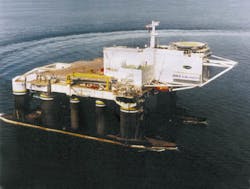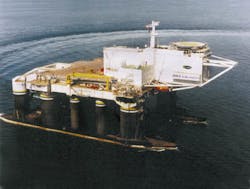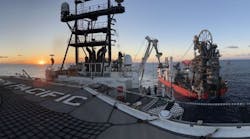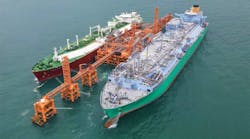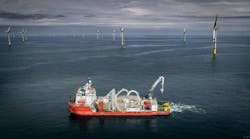Launch semi, stand-off command ship ready
William Furlow
Technology Editor
The semisubmersible Odyssey has been modified to act as a deepwater rocket launching pad for commercial satellites as part of the Sea Launch program.The much-doubted Sea Launch floating rocket launching facility is becoming a reality. The international partnership expects to launch a satellite into space from a converted semisubmersible later this year.
The mission control ship Sea Launch Commander has reached its home port in Long Beach, California, after a month-long trip from a shipyard in St. Petersberg, Russia, where it had been refitted with more than 600 tons of electronic and mechanical support equipment. The vessel is carrying the first of two Sea Launch rockets, which are modified versions of the Ukrainian-built Zenit.
In addition to serving as mission control for Sea Launch operations, the vessel is also a rocket assembly plant. Designed by Kværner Maritime and built at the company's Govan Shipyard, the vessel, called an Assembly and Command Ship (ACS) is the first of its kind, according to Sea Launch President and General Manager Allen B. Ashby.
The 667-ft, 34,000-ton vessel, can accommodate up to 250 crew members, launch technicians, and customers. It features a roll-on, roll-off cargo vessel design for the assembly and transportation of launch vehicles, and the integration of their satellite payloads.
Launching platform
The second Sea Launch vessel, Odyssey, is a self-propelled semisubmersible launch platform. It was converted from the mobile offshore drilling unit Ocean Odyssey by Kværner Maritime at its Rosenberg Shipyard in Stavanger, Norway.With this conversion, the Odyssey is among the largest semisubmersible, self-propelled vessels in the world, measuring 456 ft. in length and 220 ft in breadth. The Odyssey is currently en route from Russia, where its launch support equipment was installed.
The Odyssey should arrive in Long Beach later this month (August). While the ACS was able to travel through the Panama Canal to reach California, the Odyssey is too large to move through Panama and must be taken instead through the Suez Canal and around the world the long way, according to Boeing representative Korn.
The vessel has accommodations for 68 crew members and spacecraft personnel and is equipped with a large, environmentally controlled hangar for storage of the rocket during transit. It also has mobile transporter/erector equipment on board. The vessel has storage capacity for rocket fuels (kerosene and liquid oxygen) sufficient for each mission.
Equator launches
According to engineers connected with the project, the cheapest place on earth from which to reach outer space is the equator. Unfortunately, land is scarce at zero latitude, and what land does exist is covered by thick jungle which does not lend itself well to such projects. What is at the equator is water, millions of acres of it.With a better angle on orbital positioning, it makes economic sense to launch as close to the equator as possible. There also are safety and environmental concerns. Land-based launches can endanger human populations, disturb animal and plant life, and cause noise pollution.
Sea Launch is a project that began about six years ago on the premise that the growing backlog of satellite traffic could be relieved with a floating mobile launch base. The Sea Launch platform has been designed so that it can be used to launch a payload into any orbit, which is a key performance advantage, according to Boeing.
In addition to the two new vessels, Sea Launch has completed work on a 16-acre home port. Converted from a former US Navy installation, this satellite processing center features a payload-processing facility that includes two state-of-the-art space craft preparation areas and an encapsulation facility. This port is near the satellite manufacturing region of California and includes a warehouse that can store up to three of the Zenit launch vehicles. There is a 1,000-ft wharf for berthing the two vessels and offices for Sea Launch customers.
Launch plans
The first launch from this system will be late this year, November or December. The Odyssey will travel to a point in the Pacific Ocean about 1,400 miles southeast of Hawaii, near Christmas Island. This location is on the equator and in an area of the Pacific called the Doldrums, because of its calm weather.At the home port facility, the satellite will be loaded into the rocket's payload fairing, and prepared for mating with the rocket. En route to the launch site, the rocket, loaded with the satellite, will be assembled, joining the third stage with the first and second stages, on board the ACS. The ACS is capable of carrying three such rockets at a time. This first launch will carry the next-generation Hughes Model HS 702 communications satellite Galaxy XI into geostationary orbit. This satellite will become part of the PanAmSat Network.
Once at the launch site, the Odyssey will be ballasted and the rocket transferred from the ACS to the Odyssey in a horizontal attitude. An erector on board the Odyssey will lift the rocket into place where it will be fueled in preparation for launch. The crew of the Odyssey will then join those on the ACS, which will pull back three miles before starting the remote-controlled launch sequence.
Korn, said the three-mile limit is standard for launches on land as well as at sea. The launch is conducted from a mission control room on the ACS. The ship is in constant contact with the launch vehicle, spacecraft, customer facilities, and a backup mission control center in Russia during the launch. After the first and second stages of the rocket are spent, the Block DL-SL upper stage will guide the spacecraft to the desired orbit.
Sea Launch should be able to complete between six and eight launches a year and has 17 scheduled between now and 2000, 12 more with Hughes and five with Space Systems/Loral.
Copyright 1998 Oil & Gas Journal. All Rights Reserved.
